If you’re a cycling fan then cycling in the French Alps is one of those things you just have to experience. Whether watching the Tour de France has inspired you or simply as a result of the incredible images of snow-tipped peaks and meadows covered in cotton grass pictured in your mind, cycling in the Alps is a must for many a cyclist.
Here is Port Velo’s Cyclist’s Guide to the French Alps for our top tips on the best climbs, cuisine, coffee & places to stay.
The Alps are the highest mountain chain in Europe and cover a huge area, including France, Switzerland, northern Italy and Austria before heading south towards the Balkan states, over 600 kilometres by road.
Because of the sheer size of the French Alps it is easier to view them as regions, primarily as the North, Central and South. This should help you plan a future road cycling holiday in the Alps, however we have already done the hard work for you with Port Velo’s ‘The French Alps Cycling Tour’.
The Alps is a mountainous area of southeast France, Switzerland and Italy, in fact the word “Alp” strictly refers to an upland mountain pasture which lies just below the snow-line. They are meadows, where hay is cut in the lower fields and where, in the summer months, the Alpine farmers take their cattle to graze. There’s more on the history of the Alps here.
The Alps are made up of mountain ranges that are separated by deep valleys, most of which lie west to east and south-west to north-east.
It’s these meadows and mountain ranges that make up the cyclist’s paradise, the French Alps
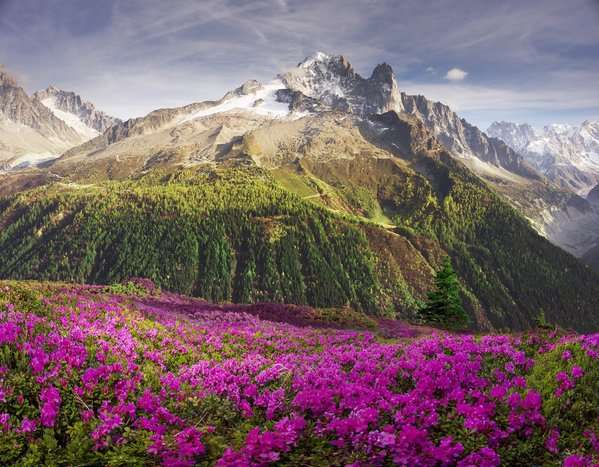
Where are the Alps?
The Alps extend north, in a crescent shape, from the Cote d’Azur up through Switzerland, northern Italy, Austria and the Balkan states.
The countries with the largest Alpine landmass are Austria 29%, Italy 27%, France 21% and Switzerland 13%.
Why go to the Alps for cycling?
The Alps attract over 100 million tourists per year, travelling from all over the world! However; the fact that the Alps are so vast it doesn’t appear that there are many people about except of course when you visit as the Tour de France rolls through.
People visit for many reasons, to explore and experience what appear to be insurmountable summits, with some peaks reaching as high as 4,000 metres. Then there are the huge glaciers and clear mountain lakes.
The warmer valleys have seemingly endless meadows, filled with cotton grass, huge forests and are home to thousands of different forms of wildlife.
The snow sits as a permanent blanket of snow around 3,000 metres above sea level, below this there is plenty of opportunity for cyclists to scale the numerous 2,000 metre plus peaks.
Many cyclists view cycling the Alps as the ultimate test to challenge themselves on the famous Tour de France climbs. Mountains such as Alpe d’Huez, Col de l’Iseran and Col de Galibier, amongst many others, have now become legendary and iconic ascents within the cycling world.
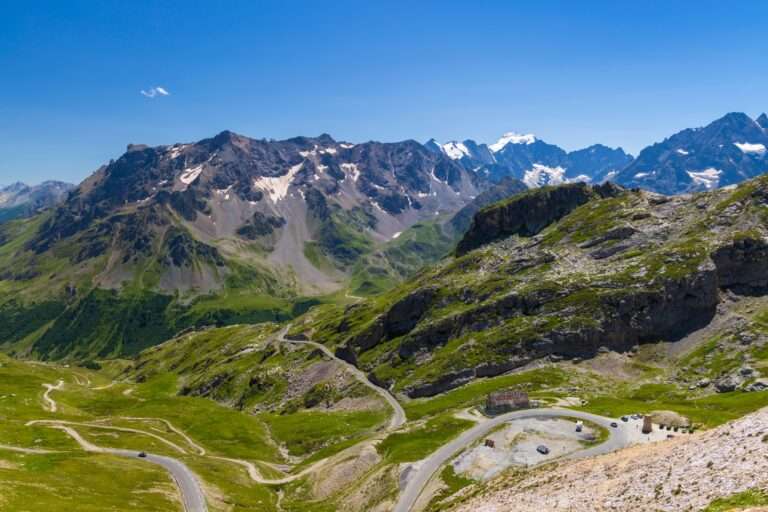
The French Alps for Cyclists
North
This route typically runs from Bourg Saint Maurice towards both Lake Annecy and Lac Leman (Lake Geneva) which encompasses some Tour de France classics such as Col de Joux Plan, Col de Colombiere and Mont du Chat.
Central
From Bourg d’Oisans northwards to the Bourg Saint Maurice area including, amongst others, the legendary Alpe d’Huez, Col de Madeleine and the Cormet de Roselend.
South
From the Cote d’Azur northwards towards Bourg d’Oisans and Briançon. This will include for example the many cycling climbs around Nice and the area around Mont Ventoux.
It can be confusing to understand the geography of the Alps as it is such a vast area. Because of this I will attempt to guide you from North to South along the route we would take you on our French Alps Cycling Holiday. There are however, a number of other climbs in the region that are well worth a visit.
This is more an insight into the cycling climbs and the French Alps towns and villages to stay in.
Northern Alps
1. Why Visit the Northern Alps?
In the north sits the most symbolic peak of the mountain range, Mont Blanc which stands at an altitude of 4,810m.
The northern mountains are home to beautiful forests of spruce and fir. Also the area between Albertville and Lac Leman is very popular due to the proximity of the well-known resorts of Lake Annecy and Bourget du Lac to the west and Lac Leman (Lake Geneva) in the north.
2. Cycling Climbs of the Northern Alps
Thonon-les-Bains and Evian-les-Bains
Sitting on the side of the glorious Lake Geneva, these grand old towns make great bases for exploring by bike. Evian-les-Bains was once fortified and is known as “the pearl of Lake Geneva”. It’s also the historical home of Evian bottled water. From these towns, you can tackle some of the smaller less famous climbs.
| Climb | Ascent (Metres) | Average Gradient % | Length (KM) |
| Col du Corbier | 495 | 8.3% | 6.0 |
| Col de Tréchauffé | 249 | 8.1% | 3.1 |
| Col de Gets | 1168 | 2.8% | 19.4 |
| Col du Grand Taillet | 316 | 6.7% | 4.7 |
Morzine
Situated near to Morzine and usually climbed together with the nearby Col de la Ramaz is Col de Joux Plan. From Morzine, you can also climb the Col du Corbier and up to the ski resort at Avoriaz.
| Climb | Ascent (Metres) | Average Gradient % | Length (KM) |
| Col de Joux Plane | 739 | 6.8% | 10.9 |
| Col de la Ramaz | 943 | 7% | 13.4 |
Chamonix
To the southeast of Morzine and Lake Geneva lies the Chamonix region. It’s near Switzerland and the imposing mountain of Mont Blanc, which lies near the French/Italian border. You can drive under the Mont Blanc, from France into Italy, through the famous Mont Blanc tunnel which is almost 12 kilometres in length.
| Climb | Ascent (Metres) | Average Gradient % | Length (KM) |
| Col des Montets. | 443 | 3.8% | 11.7 |
| Col de la Forclaz | 481 | 7.1% | 6.8 |
North of Chamonix you will find the Col des Montets followed by the major obstacle, Col de la Forclaz, just across the border in Switzerland.
Annecy and La Clusaz
| Climb | Ascent (Metres) | Average Gradient % | Length (KM) |
| Col des Saisies | 769 | 5.2% | 14.8 |
| Col des Aravis | 876 | 4.7% | 18.8 |
| Col de la Colombière | 705 | 6% | 11.8 |
To the southwest of Morzine and Lake Geneva is Lake Annecy. Nearby, the Col des Saisies and Col des Aravis are often climbed in succession in the Tour de France as are Le Grand Bornand and nearby Col de la Colombière.

All can be accessed from either Annecy or La Clusaz. There are also plenty of lesser-known climbs in the mountains surrounding Lake Annecy.
Aix-les-Bains and Lac de Bourget
West of Lake Annecy lies Lac de Bourget. On its shores sits Aix-les-Bains, which has been known as a spa since before the arrival of the Romans. From this idyllic lake, the extremely difficult Mont du Chat from Le Bourget du Lac.
| Climb | Ascent (Metres) | Average Gradient % | Length (KM) |
| Mont du Chat | 1246 | 9.2% | 13.5 |
| Col de Biche | 1019 | 7.7% | 13.2 |
| Col du Grand Colombière | 1273 | 7.2% | 17.7 |
To the north, the Col de Biche and Grand Colombière lie in wait.
3. Were to Stay – Northern Alps
The northern region of the Alps is a very popular skiing destination and because of this there are some great locations to set up a base for your cycling holiday. Ideal French Alps towns that are popular include Morzine and La Clusaz.
| Location | Climbs |
| Morzine | Col de Joux Plan, Col de la Ramaz |
| La Clusaz | Col des Saisies, Col des Aravis |
| Lake Annecy | Le Grand Bornand, Col de la Colombière |
| Lac de Bourget | Mont du Chat, Col de la Biche, Grand Colombière |
Central Alps
1. Why Visit the Central Alps?
Some of the best climbs in France if not Europe exist in this region of the Alps. This is definite classic Tour de France. The central area is very mountainous with a lot of accessible peaks at around 2,500 metres in altitude. It has a typical alpine feel, what that means is you’ll need varied clothing and layering is advisable especially for the descents!
The area here is huge and as such you’ll be advised to pick a base and cover the climbs in that area before perhaps moving to another town to do some more, you may even need to come back!
Cycling near Alpe d’Huez, French Alps
Quiet roads near Alpe d’Huez
Alpe d’Huez switchbacks above Bourg d’Oisans
Switchbacks on Alpe d’Huez
2. Cycling Climbs of the Central Alps
Along with the most famous cycling climbs in the Alps, you’ll find one of the Tour de France’s most classic climb, Alpe d’Huez with its famed 21 bends, along with Col du Galibier, and the Col de Madeleine. The region is perfect for a cycling tour of the Alps as there are so many popular mountains and routes, that’s one of reasons we created Port Velo’s Cycling Tour of the French Alps. These climbs feature on the route from North to South.
Bourg Saint Maurice

This is situated in the northern part of the central Alps, Bourg Saint Maurice is a favourite with the Tour de France.The town lies east of Albertville where you’ve got a fabulous opportunity to tick off such notable climbs as the Col de l’Iseran (north), Cormet de Roselend and Col du Pré. You also have the opportunity to explore the ascent to La Rosiere and the nearby Col du Petit Saint Bernard which tops out at the border crossing point. Here you’ll also find ski station climbs up to Les Arcs and Tignes.
| Climb | Ascent (Metres) | Average Gradient % | Length (KM) |
| Col de l’Iséran (N) | 2049 | 4.3% | 47.4 |
| Cornet de Roseland | 1183 | 6.1% | 19.3 |
| Col de Pré | 964 | 7.9% | 12.2 |
| Col du Petit Saint Bernard | 1383 | 4.5% | 30.5 |
| Colle dell’Agnello | 1459 | 7% | 20.5 |
| Colle delle Finestre | 1702 | 9.1% | 18.8 |

Bourg Saint Maurice is also situated very near to the border with the Italy. This means you are a short drive from an area in the valley of Aosta and Piemonte, which has some world class climbs made famous by the Giro d’Italia. The Colle dell Agnello, Colle dello Finestre and the climb to the ski station at Sestriere are in this region.
Moûtiers
Moûtiers is 30km southwest of Bourg Saint Maurice. Moûtiers is located deep in the Tarentaise Valley between Albertville and Bourg-Saint-Maurice. Several popular French ski resorts are located in its vicinity. The Isère flows through the town.
From here lies the Col de la Loze. The Col de la Loze is a mountain pass, with an elevation of 2,304 metres. A path up the mountain was opened in May 2019, and is the seventh-highest mountain pass in France. The ascent featured in the 2020 and 2023 Tours de France, as well as in the 2019 Tour de l’Avenir.
The new road now links the ski towns of Courchevel with Méribel and on the Courchevel side the final 5.8 kilometres of the climb are for cyclists only.
There is a Gran Fondo held here each year in July, The Gran Fondo Col de la Loze 2024. You can find out more about the Col de la Loze Gran Fondo here.
Bourg d’Oisans
Le Bourg-d’Oisans is located in the valley of the Romanche river, on the road from Grenoble to Briançon, and on the south side of the Col de la Croix de Fer. It is often on the route of the Tour de France, as the town sits at the base of the road climbing to Alpe d’Huez with 21 hairpin bends.
You are not only at the foot of Alpe d’Huez but within easy reach of Col du Lauteret, Col de la Croix de Fer and the Col du Glandon. There’s also the memorably beautiful Col de la Sarenne, the Col d’Ornon and some incredible balcony roads that merit a few days of riding.
| Climb | Ascent (Metres) | Average Gradient % | Length (KM) |
| Col de la Croix de Fer | 1502 | 5.1% | 29.1 |
| Alpe d’Huez | 1118 | 8% | 13.9 |
| Col du Lauteret | 1427 | 4.2% | 33.9 |
| Col du Glandon | 1471 | 7% | 20.9 |
| Col de la Sarenne | 958 | 7.5% | 12.8 |
| Col d’Ornon | 647 | 6.2% | 10.5 |
Saint Jean de Maurienne
One the other side of the valley from Bourg d’Oisans is the Maurienne Valley. At the heart of the Maurienne valley, where the course of the Arvan joins the Arc is a vast area whose slopes offer the variety of alpine landscapes with, in the background, the iconic Needles d’Arves. This is what has created a small town named Maurienne. This is a popular alternative to Bourg d’Oisans, and gives easy access to the very famous climbs of Col de Madeleine, Col du Télégraphe and Col du Galibier.
| Climb | Ascent (Metres) | Average Gradient % | Length (KM) |
| Col de Madeleine | 1428 | 8% | 17.8 |
| Col du Télégraphe | 837 | 7.1% | 11.8 |
| Col du Galibier | 2069 | 5.9% | 34.8 |

This year will see the Tour de France riders, after a finish in Valloire, set off on July 3rd from Saint-Jean-de-Maurienne. This will be the first French start town, for the 5th stage of the Tour de France 2024.
Vercors Region
The Vercors Massif lies south west of Grenoble and straddles the two departments of Isère and Drôme. Sometimes referred to as the Grenoble Alps or the Pre-Alps the area is also closely situated to the city of Valence and the main A7 motorway which runs south towards the Cote d’Azur and Spain.
The Vercors landscape is gnarly and undulating and famous for its many balcony roads which have been cut out of huge limestone cliffs on the top of deep gorges. Like many regions in this part of the world the Vercors Natural Park is a very popular skiing destination and as such the terrain provides ample opportunities for cyclists.
One of the well-known climbs in the Vercors is the Category 1 ascent of the Côte de Saint-Nizier-du-Moucherotte. The Tour de France has passed this way in 2020 finishing at the ski station in nearby Villard de Lans.
The area is packed with medium sized Cols and stunning gorges and is described by some as one of the most under rated areas within the entire Alpine chain.
The Vercors is also an ideal stopover area if you are travelling south and want to break up your journey and stretch your legs for a day or so on the bike. There are ample accommodation and restaurant facilities in Grenoble as well as in the old medieval town of Romans sur Isère which is even closer to the motorway.
As we are discussing the French Alps, it would be remiss not to mention the Marmotte Granfondo Alpes. Every cyclist has at some point heard the name of this legendary cyclosportive, sometimes for its frenetic atmosphere with its motley, multilingual peloton, certainly for the beauty of its route, and undoubtedly for the difficulty and sequence of its legendary passes. In reality, the Marmotte Granfondo Alpes is all this and more!
The Marmotte Granfondo Alpes has become the must-attend international cyclosportive event, and the most important one-day cycling event of the summer in the Alps, after the Tour de France.
A series of 5 of France’s most legendary passes: the Glandon, the Télégraphe, the Galibier, the Lautaret, and finally the final ascent of Alpe d’Huez.

Each year 7,500 cyclists ride the 175-kilometre loop, with around 5,000 metres of elevation, starting in Bourg d’Oisans and finishing at the top of nearby Alpe d’Huez.
3. Where to Stay – Central Alps
The towns and ski resorts of this region are well catered for in terms of accommodation, particularly in the summertime with all the usual facilities.
Choose Bourg d’Oisans, Saint Jean de Maurienne or Bourg Saint Maurice and not only will you will be well catered for in terms of accommodation and facilities, but you will have sufficient climbs to keep you well occupied for at least 4 or 5 days of riding some of the best French Alps cycling routes.
| Location | Climbs |
| Bourg d’Oisans | Alpe d’Huez, Col du Glandon,Col de la Croix de Fer, Col du Lauteret |
| Saint Jean de Maurienne | Col des Saisies, Col des Aravis |
| Moûtiers | Col de la Loze |
| Bourg Saint Maurice | Col de l’Iséran (N), Cornet de Roseland, Col de Pré, Col du Petit Saint Bernard |
Southern Alps
1. Why Visit the Southern Alps?
The Southern French Alps is a large area with a huge variety of landscapes, from high mountain glaciers in the Ecrins National Park to beautiful turquoise blue lakes like the Serre-Ponçon Lake with its many beaches and breath taking sceneries.
The southern Alps also feels different to the northern and central Alps. The area is steeped in history, usually warmer and less affected by snow. As a result the Durance valley is the fruit basket of France with orchards of apples, pears, apricots and peaches stretching for miles.
Photo – See article
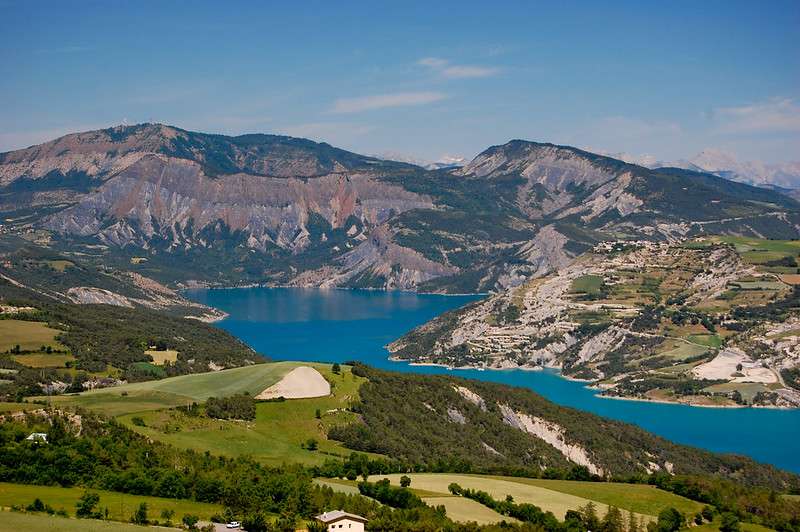
Because the area is quieter, it’s great for road cycling with many more of the famous Tour de France cols in the area.
The capital of the Hautes-Alpes is the city of Gap, which has earned the title of ‘Sportiest town of France’ thanks to its many sporting clubs and associations. It’s not really surprising given it’s position! It has hosted the Tour de France numerous times as well as other world famous sporting events like the Monte Carlo Rally. As a town, it looks very Provencal with tall coloured buildings decorated with a variety of shutters, large pedestrianised squares set out with tables and chairs around the fountain for a relaxed coffee and people watching.
The Alps in the south are more famous for climbs on the route of the Paris-Nice stage race. With the Alps range starting almost on the Côte d’Azur – also known as the French Riviera – there are stunning climbs like the Col de Turini and Col de la Madone within striking distance of Nice and the coast. However, where the Alpes meets the coastline, on the Cote d’Azur, the scenery and climate mean it’s been attracting the rich and famous (as well as holidaymakers!) for decades and as such can be very busy. The cycling is still excellent however.
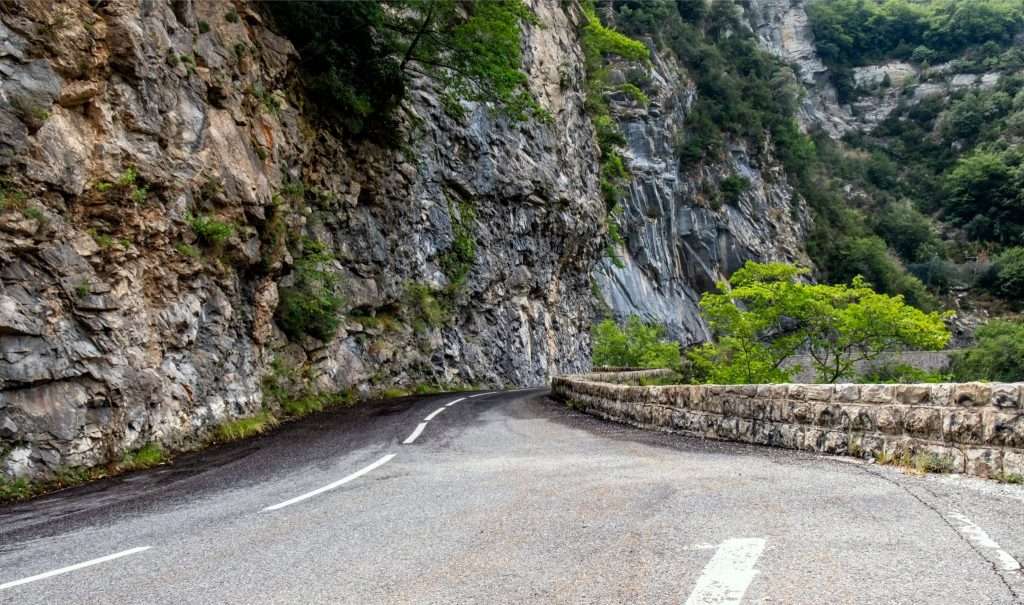
Tour de France history, challenging climbs and a very temperate climate mean that it’s clear why a lot of the leading professional cyclists now make this area their home.
2. Cycling Climbs of the Southern Alps
Provence
Around 200km southwest of Bourg d’Oisans, lying in the Provence region is the Géant de Provence or as its better-known Mont Ventoux. Standing alone adjacent to the Baronnies National Park in Provence at just under 2,000 metres above sea level the mountain can be seen from miles around.
Mont Ventoux is a classic of the Tour de France, the highest mountain in the region and has been nicknamed the “Beast of Provence” or the “Giant of Provence” or “The Bald Mountain” due to its very unusual lunar style landscape.
| Climb | Ascent (Metres) | Average Gradient % | Length (KM) |
| Mont Ventoux | 1594 | 7.7% | 20.8 |
Provence is very much old fashioned France and is almost synonymous with its markets, which are filled with all its bounty – cheese, wine, local fruits and vegetables, nougat, honey, olives and tapenade, soap..etc. There are untouched idyllic villages, local cuisine and mile after mile of fertile vineyards. The hills are adorned with lavender and olive trees which form the perfect backdrop to tantalisingly perched settlements with pavement cafés and locals playing pétanque in the village square.
Barcelonette
The small town of Barcelonette ia around 150km southeast of Bourg d’Oisans and 150km due north from Nice. It sits in the valley of the river Ubaye at an important strategic crossroads, close to the border with Italy. There is the trio of the Col de la Cayolle, Col d’Allos and Col des Champs which are a brutal loop just south of Barcelonnette packing 3,270m of vertical into just under 120km.
| Climb | Ascent (Metres) | Average Gradient % | Length (KM) |
| Col de la Cayolle | 1198 | 4.4% | 27 |
| Col d’Allos | 1105 | 6.5% | 12.5 |
| Col des Champs | 821 | 7.1% | 11.5 |
| Col de la Bonett | 1590 | 6.8% | 23.3 |
The main reason for cyclists to visit is the Col de la Bonette. It holds the title of being, at 2,802 metres above sea level, the highest paved road in Europe.
Bédoin
Made famous by the Tour de France route, cycling is the number one activity that breathes life into the village of Bédoin and makes it so attractive in the summer season.
It is home to ”kilometre zero”, it is the favourite starting point for cyclists who come to tackle the famously difficult climb of the southern face of Mont Ventoux.
Bédoin is a very popular village with cyclists from all over the world who come to take up the challenge. While scaling the Giant of Provence can be gruelling, Bédoin promises a laid back lifestyle to all who stay there, due to its Mediterranean climate and friendly residents.
With its weekly Monday market, the village of Bédoin comes to life and you will find excellent regional products and local crafts. There is also the constant wave of sports enthusiasts and cyclists passing through, and the joie de vivre exhibited by village residents playing pétanque or enjoying a few drinks on the terrace.
Malaucène
Ideally located along the northern road of Mont Ventoux, Malaucène is a village with a long history through the centuries and where traces of its glorious past are still visible to this day.
The main square, lined with century-old plane trees and dotted with wash-houses and fountains, is a particularly lovely place to stroll. You can also explore the labyrinth of lanes, transporting you back in time between its medieval gateways that survived the demolition of the 13th-century ramparts, its belfry built in the 15th century and its many private houses designed between the Renaissance and the 18th century.
While for a long time Malaucène lived off agriculture, the paper-manufacturing industry and silkworm breeding, the village is now experiencing a revival thanks to tourism and its strategic position from which thousands of cyclists every year embark upon the ascent of the Giant of Provence.
Malaucène
Less well-known than the ascent departing from Bédoin, the northern face of Mont Ventoux starts from Malaucène. The total elevation is 1535 m (5035 feet), spread over 21 km (13 miles) with an average 7% incline, increasing to 11% along certain sections of the route.
Nice and the Cote d’Azure
Arguably the ultimate holiday destination for cyclists – and home to countless pro racers – Alpes-Maritimes pairs some of cycling’s iconic climbs with the stunning Côte d’Azur – aka, the French Riviera – and hotspots of Nice and Monaco. Mediterranean chic combines with some excellent year-around riding to make Nice and the Cote d’Azure a great cycling location. Climb the Col de la Madone and the hairpin laden ascents of the Col du Turini and Col de Braus early in the morning and you are sure to see a professional out on the road on a training ride.
| Climb | Ascent (Metres) | Average Gradient % | Length (KM) |
| Col de la Madone | 916 | 6.3% | 14.6 |
| Col du Turin | 1250 | 5.2% | 24.1 |
| Col de Braus | 637 | 5.7% | 11.1 |
3. Where to Stay – Southern Alps
| Location | Climbs |
| Barcelonette | Alpe d’Huez, Col du Glandon,Col de la Croix de Fer, Col du Lauteret |
| Bédoin | Col des Saisies, Col des Aravis, Mont Ventoux |
| Malaucène | Col de la Loze, Mont Ventoux |
| Nice | Col de l’Iséran (N), Cornet de Roseland, Col de Pré, Col du Petit Saint Bernard |
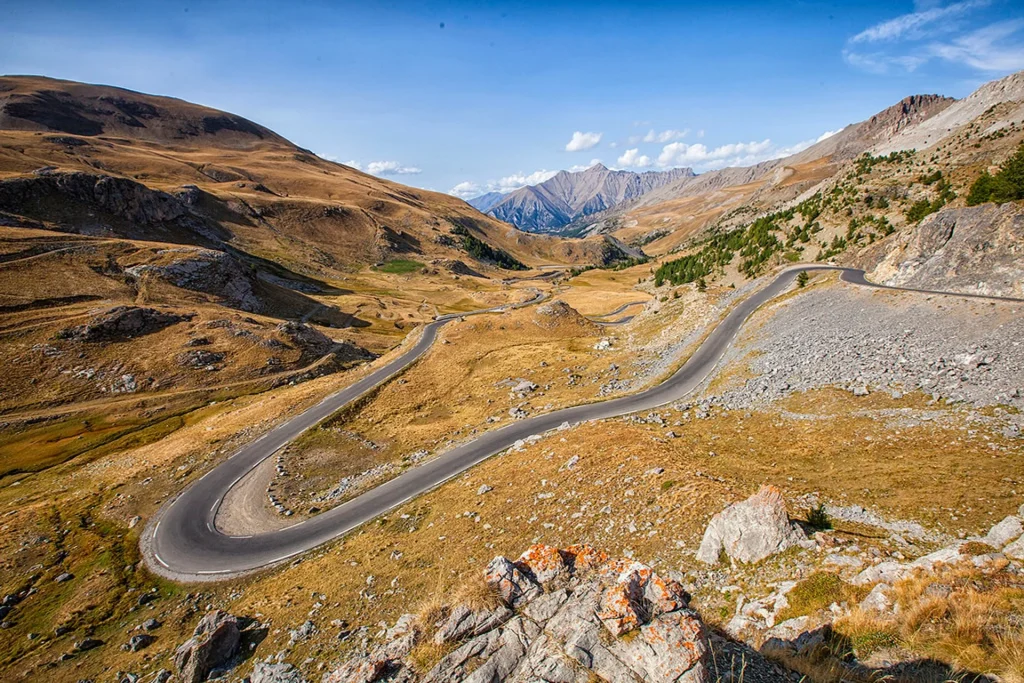
4. More Information
If you’re looking for a route that runs through the different regions of the Alps, the Routes des Grandes Alpes is for you. 700 kilometres of cycling from Geneva to Nice! Check out Port Velo Cycling Tours ‘The French Alps Cycling Tour’ following the Route des Grandes Alpes.
CONCLUSION
Whichever part of the Alps you choose, you’ll find great cycling and incredible scenery, so whatever location you start from you’ll have great riding, great scenery and amazing memories.
Another thing to note is that the French Alps in the summer months are very popular so consider making your travel plans early, particularly in relation to your accommodation.
FAQ’s
One thing we haven’t discussed is the weather. When you’re cycling in the Alps, the weather is very relevant to your enjoyment (and safety!). To help you decide when to visit, we’ve set out listed a set of questions to consider help you decide
1. When is the Cycling Season?
If you visit a town out of cycling season, you may find that many places are either shut or still focused on winter sports (and so can’t offer services like bike hire, guiding and repair).
Here are some rules of thumb for the cycling seasons in the Alps:
- Below 1500m – middle of April to the middle of October
- Above 1500m – middle of May to the end of September
Obviously, its not a perfect science, so once you’ve decided where you want to visit, check they’ll be open.
2. Will the Routes I want to Ride Open?
Many mountain passes close during the winter.
More rules of thumb:
- Lower than 2000m usually open from April/May to the end of October.
- 2000m to 2500m usually open from late May/early June to late October.
- Above 2500m usually open from early/mid-June to mid-October.
3. What’s the Weather Like?
The weather is variable and changes quickly in the high mountains (both day to day and year to year). It’s possible you’ll hit adverse weather at any time of year.
July and August give the best chance of sunshine and low rainfall. When it does rain, it’s often as violent thunderstorms in the mid-afternoon. Even in summer, there may be snow on the mountaintops.
November to March are usually too cold to make cycling enjoyable. For every 1000 m additional altitude, the temperature drops by 6.5℃. It can be even more, particularly when you look at the difference between the valleys and high cols. For example, if it’s in the 30℃ in the valley, it could be 10℃ at the top of the mountain. It can feel even colder if the wind is blowing and you consider the windchill factor when you descend.
Check the weather forecast before you set out for the day.
At a glance guide to cycling weather in the Alps
January
At this time of year you will find Skiers and snowboarders in charge
Average highs: 12-24 ℃
Rainfall: 28-37% chance of rain/snow
February through to May
These months can be unpredictable, from warm sun to cold rain. Depending on winter snowfall, some of the cols over 2000m may be closed until early/mid-June.
Average highs: 27-31℃
Rainfall: 31-39% chance of rain
June to July
All the cols should be open. This is the time of year when for three weeks the Tour de France visit. It can get busy.
Average highs: 32℃
Rainfall: 35-42% chance of rain
August to September
September can be a good time to visit the Alps since temperatures in September and October remain high with averages of 21 and 18 respectively. This is why Port Velo’s French Alps Cycling Holiday Tour is this September form the 7th. However, these are typically the two most rainy months, with averages of 54 and 71mm.
Average highs: 8-21℃
Rainfall: 8-71mm, 7-11 days per month
October to November
Temperatures in November and December are cooler (11 and 8℃ respectively) but average rainfall dramatically reduces (11 and 8mm). This time of year could be too cold for cycling.
Average highs: 13-18℃
Rainfall: 30-37% chance of rain/snow
4. Are There Any Events in the French Alps?
Apart from the obvious three week extravaganza in June and July, namely the Tour de France there are many major sportives in the area. The Alps hosts some of the world’s most famous sportives, with thousands of people descending on the start towns:
La Marmotte: 174km and 5000m of climbing (first weekend of July) and 7,500 participants – La Marmotte sportive route is the same each year and gives you the chance to ride the Col du Glandon, Col du Telegraphe, Col du Galibier and Alpe d’Huez all on closed roads. It’s one of the most famous and difficult sportives in the world.
L’Etape du Tour: around 180km and 3500m of climbing (mid July) and over 11,000 participants – the sportive is organised by the ASO, the organisers of the Tour de France. The route is different each year as the sportive allows cyclists to test themselves against the same route as a Tour de France stage, on closed roads. It’s generally held on one of the important mountain stages in the Alps or Pyrenees. It’s so famous it’s now a festival of cycling, rather than just a one-day event, spread out over a long weekend.
Haute Route Alps: 896km and 22,200m of climbing between Nice and Geneva over seven days (mid-late August) – this is the original event of the European Haute Route sportive series, and it’s one of the hardest sportives on the international calendar.
There are many more cycling sportives in the Alps. Another example is the Col de la Loze sportive from Brides-les-Bains.
Where to Stay
Geneva, Nice, Grenoble and Avignon are major centres with plenty of accommodation. Others worth considering are Annecy, Bourg-Saint-Maurice, Briançon or Chamonix for the northern Alps and Barcelonnette or Gap for the south.
Another option is to head to the heart of the action and look for accommodation in a ski town. Out of season, they’re usually quiet, likely to be cheaper than in winter and have facilities like spas, swimming pools and decent restaurants. Plus there’s almost certain to be a climb back to the resort at the end of the day, because that’s what you want, right?
IF YOU LOVE CYCLING AS MUCH AS US LET’S KEEP IN TOUCH! SIGN UP TO OUR NEWSLETTER AND GET 10% OFF YOUR NEXT CYCLING HOLIDAY WITH PORT VELO

Leave a Reply